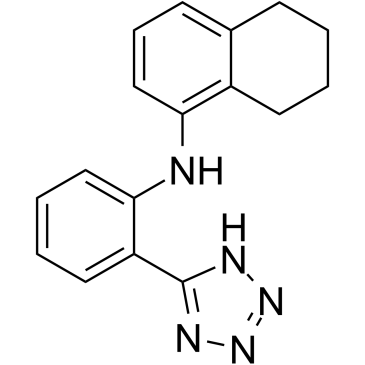18200-13-0
| Name | N-[2-(2H-tetrazol-5-yl)phenyl]-5,6,7,8-tetrahydronaphthalen-1-amine |
|---|---|
| Synonyms |
(5,6,7,8-Tetrahydro-naphthalen-1-yl)-[2-(1H-tetrazol-5-yl)-phenyl]-amine
5-(2-(Cyclohexano<b>anilino)-phenyl)-tetrazol UNII-5E7RR1J6TR (5,6,7,8-tetrahydro-naphthalen-1-yl)-[2-(1H-tetrazol-5-yl)-phenyl]-amine BL-1249 |
| Description | BL-1249 is a nonsteroidal anti-inflammatory drug (NSAID) and a potassium channel activator. BL-1249 potently activates K2P2.1 (TREK-1) and K2P10.1 (TREK-2) with EC50 values of 5.5 μM and 8.0 μM, respectively. BL-1249 extracellular application activates all TREK subfamily members but has no effect on other K2P subfamilies. BL-1249 exhibits more selective for the bladder (EC50 of 1.26 μM) than vascular tissue (EC50 of 21.0 μM)[1][2]. |
|---|---|
| Related Catalog | |
| Target |
EC50: 5.5 μM (TREK-1) and 8.0 μM (TREK-2)[1] |
| In Vitro | BL-1249 produces a concentration-dependent membrane hyperpolarization of cultured human bladder myocytes, assessed as either a reduction in fluorescence of the voltage-sensitive dye bis-(1,2-dibutylbarbituric acid)trimethine oxonol (EC50 of 1.26 μM) or by direct electrophysiological measurement EC50 of 1.49 μM). BL-1249 produced a concentration-dependent hyperpolarization with an EC50 of 21.0 μM in human aortic smooth muscle cells[1]. In in vitro organ bath experiments, BL-1249 produces a concentration-dependent relaxation of 30 mM KCl-induced contractions in rat bladder strips (EC50 of 1.12 μM), yet has no effect on aortic strips up to the highest concentration tested (10 μM). The bladder relaxation produced by BL-1249 is partially blocked by Ba2+ (1 and 10 mM)[1]. BL-1249 is a selective agonist of the TREK subfamily when applied extracellularly, having preferential action on K2P2.1(TREK-1) and K2P10.1(TREK-2) over K2P4.1(TRAAK) and establish that its mechanism of action relies on gating at the selectivity filter C-type gate[2]. |
| In Vivo | BL-1249 (1 mg/kg) inhibits isovolumic bladder contractions in vivo. The short duration of the effect of BL-1249 on bladder contraction ( 30 min) is likely due to a fast elimination half-life of the compound after i.v. administration (0.69 h)[1]. BL-1249 (1 mg/kg) has little effect on mean arterial blood pressure, an observation again consistent with the in vitro bladder to vascular relaxant selectivity[1]. |
| References |
| Density | 1.291g/cm3 |
|---|---|
| Boiling Point | 492.6ºC at 760 mmHg |
| Molecular Formula | C17H17N5 |
| Molecular Weight | 291.35000 |
| Flash Point | 251.7ºC |
| Exact Mass | 291.14800 |
| PSA | 66.49000 |
| LogP | 3.56210 |
| Vapour Pressure | 7.57E-10mmHg at 25°C |
| Index of Refraction | 1.684 |
| Symbol |

GHS07 |
|---|---|
| Signal Word | Warning |
| Hazard Statements | H315-H319-H335-H413 |
| Precautionary Statements | P261-P305 + P351 + P338 |
| Personal Protective Equipment | dust mask type N95 (US);Eyeshields;Gloves |
| RIDADR | NONH for all modes of transport |
| HS Code | 2933990090 |
| HS Code | 2933990090 |
|---|---|
| Summary | 2933990090. heterocyclic compounds with nitrogen hetero-atom(s) only. VAT:17.0%. Tax rebate rate:13.0%. . MFN tariff:6.5%. General tariff:20.0% |
